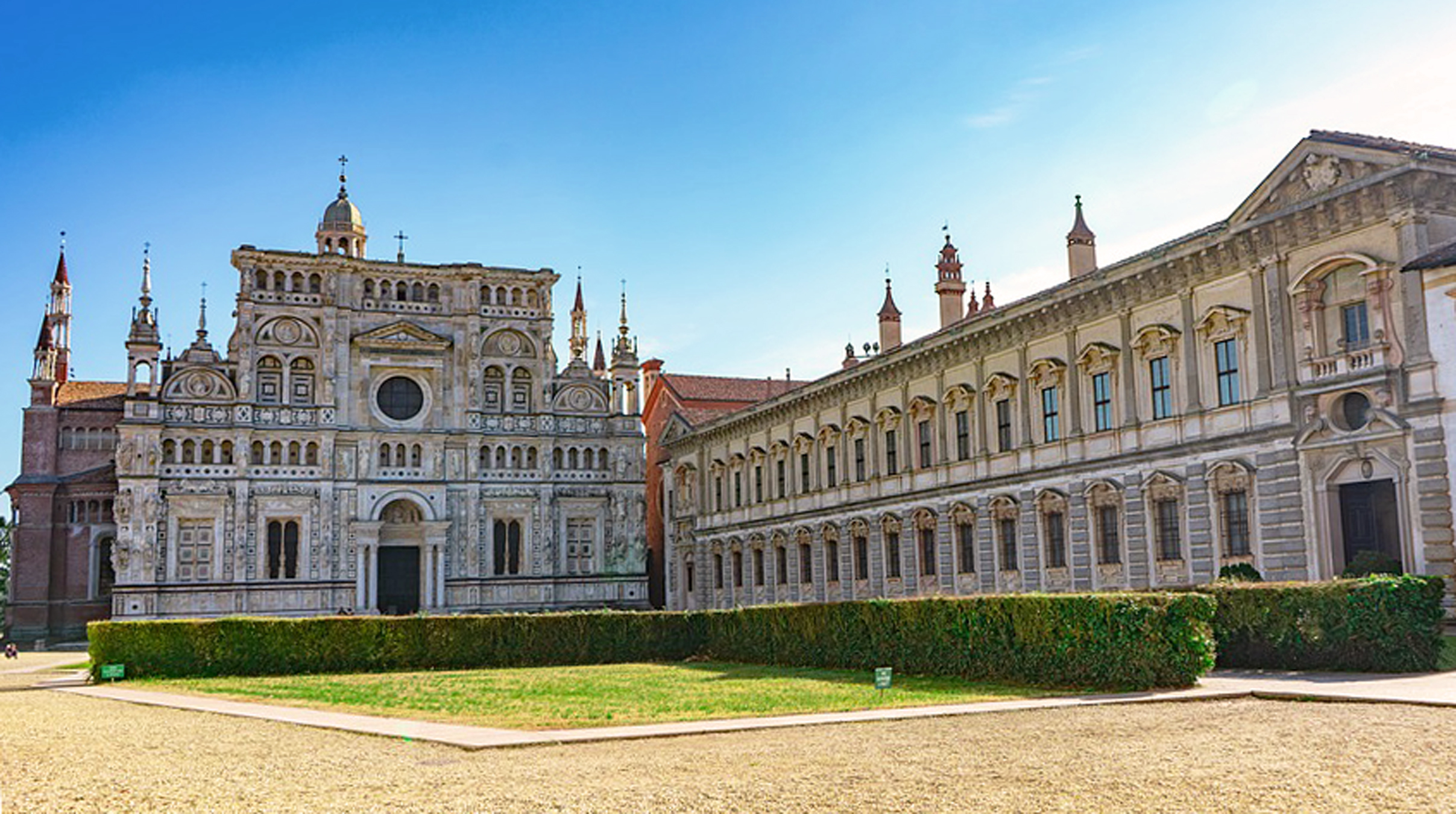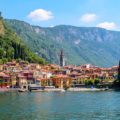The Province of Pavia is located in the region of Lombardy. To the north is the metropolitan area of Milan, while to the east is the Province of Lodi. It borders the region of Emilia Romagna to the south and the Piedmont to the west.
The province is known for its rice, dairy and wine products. Primarily flat, the northwestern part of the province is devoted to agriculture, growing rice and cereal crops, dairy farms and vineyards. It is the largest area in Italy for the production Pinot Noir wine. The southern part of the province rises to low hills which give way to the Ligurian Apennines. The town of Pavia has a major position in northern Italy’s textile industry and is renowned for hat making, but is an important center for engineering and metallurgical industries.
Pavia was initially settled by the Ligures and was conquered by the Romans in 220 BC who named the present capital of the province Ticinum. It became a key part of the Roman defenses in northern Italy and was the most forward Roman military outpost in the Po Valley during the Second Punic War against Carthage. As a garrison city, it became a target for invaders as Rome struggled to maintain its empire during the fifth century AD.
It was at Pavia in 476 AD that the reign of Romulus Augustulus, the last emperor of the Western Roman Empire came to an end. The emperor’s father, Flavius Orestes had dethroned the previous emperor, Julius Nepos and installed his son as emperor. Within months, one of the garrison’s officers, Odoacer, led a rebellion. Orestes was killed and Odoacer pronounced himself sovereign of the new Kingdom of Italy, but peace was not at hand. The Ostrogoth King Theodoric soon invaded Italy. War waged for five years. On March 15, 493, Theodoric invited Odoacer to a banquet among equals to share the rule of Italy. During the dinner, Odoacer was slain by his rival.
Theodoric began a vast building program in Pavia, including the construction of a palace complex that would later become the residence of the next monarchs of the land. The Lombards invaded Italy in 568 and captured much of northern Italy, but their progress was halted in 569 at Pavia. The city withstood a siege of three years before succumbing and becoming the main capital of the new rulers.
The city of Pavia played a key role in the war between the Lombard Kingdom of Pavia and the Franks, led by Charlemagne. In 773, he declared war and invaded across the Alps into northern Italy defeating the Lombards. Pavia remained the capital of the Italian Kingdom and the center of royal coronations into the 12th century.
Pavia, situated just south of Milan, held out against domination of powerful the city, but finally yielded to the Visconti family. They ruled the city beginning in the 14th century and made Pavia an intellectual and artistic center, founding of the city’s university in 1361.
The Duomo di Pavia began construction in 1488. However, over the course of the next four centuries, only the façade and the dome had been completed. The central dome has an octagonal plan and reaches a height of 320 feet, making it the third largest in Italy after Saint Peter’s Basilica and Santa Maria del Fiore in Florence. Next to the Duomo had been the Civic Tower, which was built in 1330 and enlarged in 1583. Its fall on March 17, 1989 propelled the massive engineering efforts to save the Leaning Tower of Pisa from a similar fate.
The city of Pavia has three basilicas. San Michele Maggiore is an outstanding example of Lombard-Romanesque church architecture. Located on the site of a pre-existing Lombard church, the lower part of the campanile belonged to the earlier church. Completed in 1155 for the crowning of Emperor Frederick Barbarossa, it is characterized by an extensive use of sandstone and by a very long transept.
The Basilica of San Pietro in Ciel d’Oro contains the remains of St. Augustine, the late Roman era philosopher; Boethius and the Lombard King Liutprand. Originally constructed in the sixth century, the present basilica dates from the early 12th century. The arch housing the relics of St. Augustine was built in 1362 and is decorated by some 150 statues and reliefs. The church is mentioned by Dante Alighieri in the X canto of his Divine Comedy.
San Teodoro is the smallest of the three and is situated on the slopes leading down to the Ticino River. Inside are two outstanding bird’s-eye-view frescoes of the city, dating to 1525 and attributed to Bernardino Lanzani. Impressively detailed, the frescoes reveal how Pavia’s urban layout is remarkably unchanged over the past 500 years.
The city also contains the large 14th century Castello Visconteo. Built as the family’s residence rather than as a stronghold, the early Renaissance poet Petrarch was in charge of the magnificent Visconti library. The Castle is now home to the Musei Civici.
Pavia’s most famous landmark is the Certosa, a Carthusian monastery, founded in 1396 and located on the northern edge of the city. It is one of the largest monasteries in Italy. The church, intended as the family mausoleum of the Visconti’s, was completed in the mid-15th century as the last major building of the complex. It was designed as a grand structure with a Gothic-style nave. The Certosa includes a huge collection of artworks dating from the 15th to 18th centuries and in 1866, was declared a National Monument.
A number of medieval towers still shape Pavia’s skyline, although they are not open to the public. The main clusters are found in Piazza Leonardo da Vinci with three towers; Via Luigi Porta, two towers and one in Piazza of Collegio Borromeo.
Pavia is a major Italian college city, with several institutes, universities and academies, including the University of Pavia, one of the oldest in Europe. It originally was a school of rhetoric that dated back to 825. The Centrale building is a wide block of twelve courts dating from the 15th to 19th centuries, with façades shifting in styles from Baroque to neoclassic. Within the halls can be found the Cortile degli Spiriti Magni, which hosts statues of some of the most important scholars and alumni. The Orto Botanico dell’Università di Pavia is the university’s botanical garden and numerous museums, including the University History Museum and the Natural History Museum of Pavia are found within the campus.
While in the area, visitors should take the opportunity to visit nearby Vigevano. The town contains Castello Sforzesco, a stronghold rebuilt in the late 15th century. Both Leonardo da Vinci and Bramante were entertained as guests at the castle. Piazza Ducale was built in the same period as a noble forecourt to the castle. Its arcades completely surround the square, which, unsurprisingly for the province, is impressive in both its scale and history.





